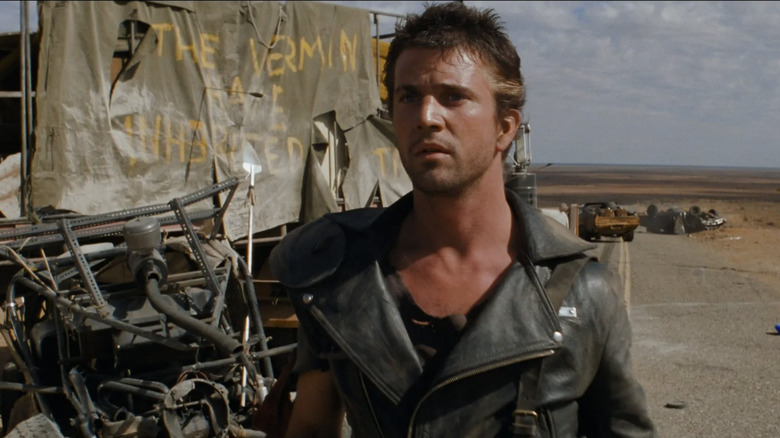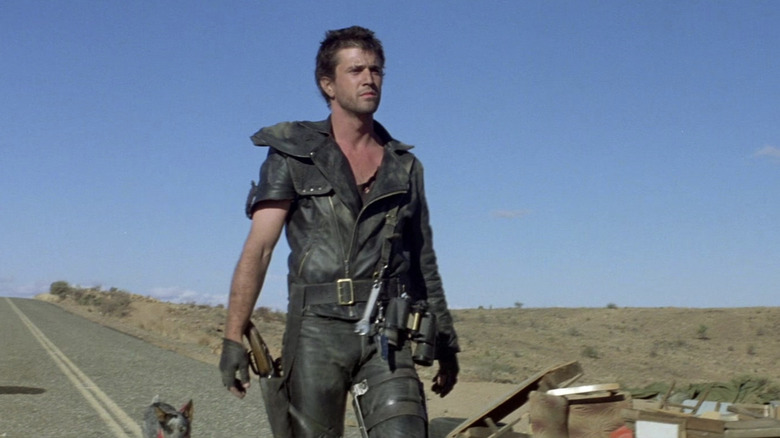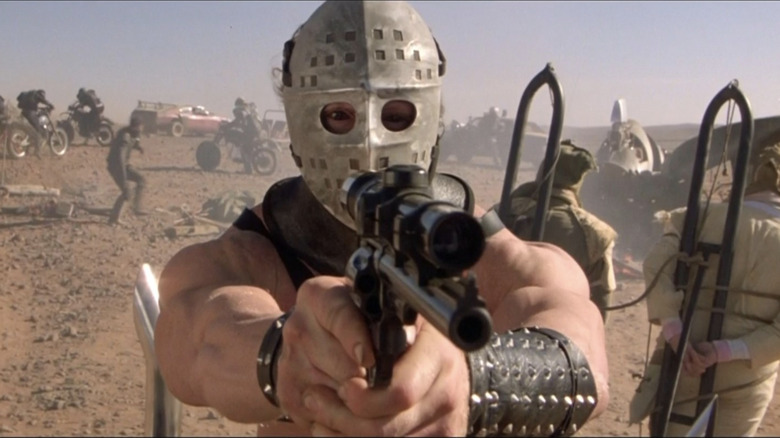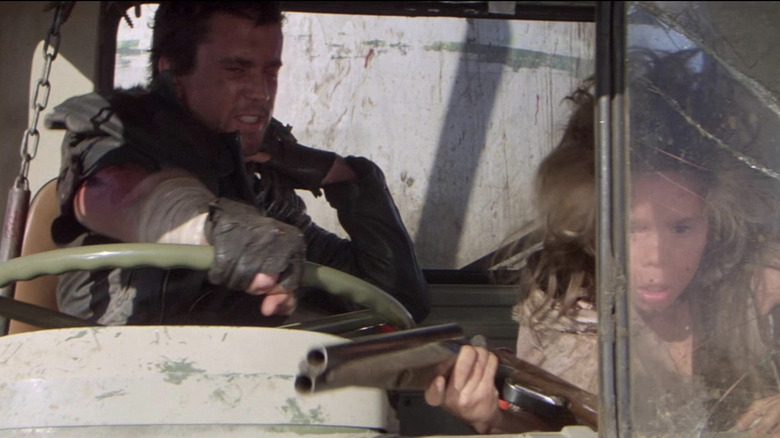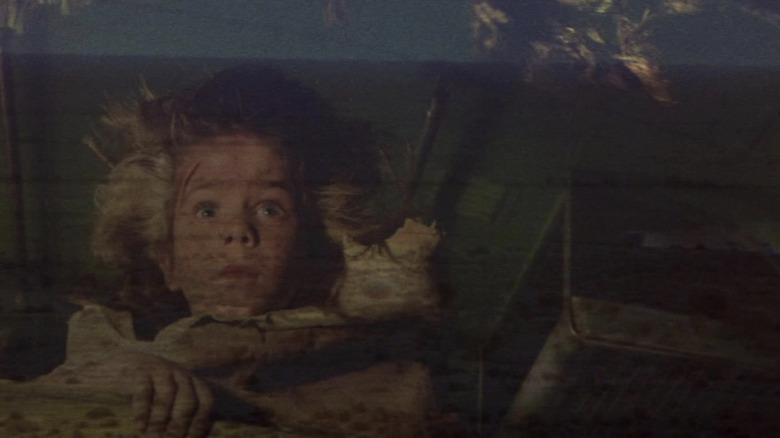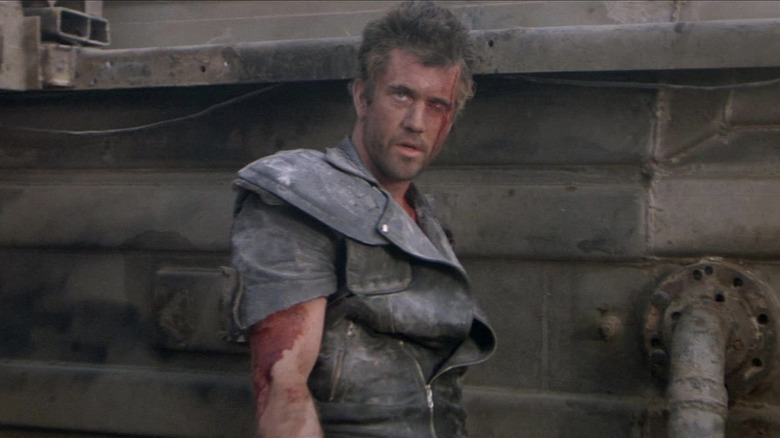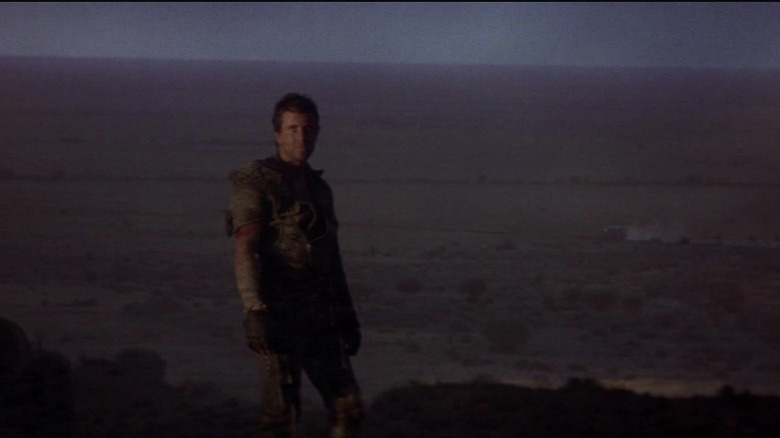The Road Warrior Ending Explained: The Legend Of Max Rockatansky
If you were to try and sell audiences on "Mad Max 2" in the 1980s, they would immediately dismiss the film mainly because North American audiences had no idea that there was even an original "Mad Max" film in the first place. Since so few had seen the original "Mad Max"' during its North American debut, the idea came to repackage "Mad Max 2" into a much more intriguing title. Enter: "The Road Warrior"
"The Road Warrior" would become the "Mad Max" film that would set a precedent for future "Mad Max" movies and make Mel Gibson's weary and reluctant post-apocalyptic hero one to permeate throughout pop culture at the time. Moreover, the story and ending narration propels the character of Max into one of legend.
Whereas the original "Mad Max" was much more subdued in its action and storytelling (partly due to its shoestring budget), "The Road Warrior" would up the ante in all the right ways. The final product is a film that can stand toe-to-toe with some of the most incredible action films today — with a simple story structure with lasting influence would be seen in a sequel released nearly 35 years later.
World weary Max
"Mad Max," released in 1979, told the origin story of Max Rockatansky and his fall from grace, ending with him becoming a disillusioned and near-insane warrior of the road. The 1982 sequel, "The Road Warrior," would pick up an untold number of years after the original.
As mentioned earlier, this film was a starting point for North American audiences, so a short opening narration quickly recaps the original movie. Part of what makes "The Road Warrior" such an incredible sequel is that the first film isn't required viewing for its enjoyment. The apocalypse in the "Mad Max" series of films is timeless, existing in a vacuum of despair and high-octane vehicular combat.
"The Road Warrior" tells the story of a small group of survivors living in a gas refinery, and their futile attempts to fend off a hoard of marauders after their gasoline, with Max caught in the middle. The structure and narration featured at the beginning and end of the film make the character of Max feel like something out of a legend, a tale told to generations. "The Road Warrior" has a larger-than-life feel, giving the film a different feeling than the original "Mad Max." It's almost as if Miller used the first film as a test run, with "The Road Warrior" fully embracing the themes and concepts introduced in the original film while expounding upon them in new and exciting ways.
Fighting against the madness
"The Road Warrior" features a broken world filled with all types of uniquely designed and colorful characters. No character is a better example of that than the film's main antagonist, Lord Humungus. The character of Humungus has become a staple of the post-apocalyptic aesthetic, and his band of leather-clad feral riders of the night accentuates the stakes of "The Road Warrior."
While Max is far-gone in his endeavors as a lone wanderer, Humungus and his gang are a reminder of what Max could become if he strays too far into his more primal instincts. The speeches and promises of violence Lord Humungus gives if he doesn't get his way solidify how the world of "The Road Warrior" works.
The people fighting against that world, the survivors living in the gas refinery, are portrayed as stark opposites of Humungus and his crew. The former are dressed in white and bear some semblance of humanity. This stark contrast to the more violent, anti-social people of this world have Max at a literal and metaphorical crossroads: Does he succumb to the madness represented by the outside forces of Humungus, or does he regain some of his humanity and help those living in the refinery plan their escape?
Vehicular action with a purpose
Max's decision after having a near-death experience with Humungus and his men shows what "The Road Warrior" is really about. The savageness of Humungus and his men drives Max to take a stand, helping the people living in the refinery plan an escape with as much gasoline as they can carry. In turn, Max would regain some of the humanity he lost in the earlier years of the post-apocalyptic world.
The third act in "The Road Warrior" is almost entirely an extended action sequence, which shows the cost Max pays for his benevolence. Performed by expert stunt men and choreographed and filmed so as not to miss a single crash, punch, or explosion, "The Road Warrior" has incredible action — but it serves a purpose greater than just shallow thrills. The climax represents Max putting himself on the line for a community — a community that he cannot be a part of. It's the ultimate, selfless act.
The "Road Warrior" ending isn't all straightforward action and explosions. The twist shows Max never drove a big rig filled with gasoline — instead, the survivors and Max filled the tanker with sand. The twist shows the newly developed selflessness in Max compared to his selfish survivor mentality at the beginning of the film. More than that, the closing narration that follows this big chase shows Max's ascension to myth in the eyes of other survivors.
From man to myth
"The Road Warrior" ends on a powerful note, focusing on the feral kid, a character in some brief but amusing scenes in the film. He is one of the children living in the gas refinery, but with an appearance and demeanor fitting of a miniature caveman. His admiration and curiosity with Max close the film, along with narration returning from the film's beginning.
The narrator is revealed to be the Feral Kid, who would go on to be the leader of what is then known as "The Great Northern Tribe." He speaks about how he never saw Max again, with the road warrior only living in his memories, ending the film on an ambiguous note about the fate of Max Rockatansky.
The closing narration of "The Road Warrior" elevates the character of Max Rockatansky from man to myth. He is no longer just a shell of his former self, as he was at the film's start, but it's a somber and mythical ending because it shows Max can never truly find peace or belonging again. The legend of Mad Max would continue in the sequel and third film in the series, "Mad Max: Beyond Thunderdome." The follow-up film was in no small part thanks to the critical and financial success of "The Road Warrior."
Beyond Thunderdome and the future of Mad Max
"Mad Max: Beyond Thunderdome" would be the first "Mad Max" film George Miller would create without his producer and co-creator, Byron Kennedy. Unfortunately, Kennedy died in a helicopter crash while scouting locations for the film, causing the production of the film to be rooted in tragedy.
Miller's hesitated to carry on without his co-creator but did so anyways. "Thunderdome" explored many similar ideas and concepts introduced in "The Road Warrior," albeit with different locales and supporting characters sporting a lighter tone while pulling its punches with its action. "Beyond Thunderdome" would be the first and only "Mad Max" film not to have an "R" rating. Moreover, while the "Thunderdome" itself would become a phrase used in pop culture after the film's release, its iconography and story wouldn't be as popular as that of "The Road Warrior."
The franchise would be put on a 30-year hold following "Thunderdome," with societal changes and tragedies frequently sending "Mad Max: Fury Road" into development hell until its eventual release in 2015. Even after such a long time, the premise of "Fury Road" would follow many of the same story beats as "The Road Warrior." Max would stumble into another new crusade against dictatorial forces and a massive big-rig chase to end it all. Most importantly, "Fury Road" would feature an eerily similar emotionally powerful ending that shows Max blending into a crowd, never joining in the sense of community and safety he helps establish.
The Mad Max gold standard
The ending of "The Road Warrior" is essential because it establishes the character of Max as something out of legend. His appearances in future films, "Mad Max: Beyond Thunderdome" and "Mad Max: Fury Road," continue to give Max the mythic status first shown in "The Road Warrior." The subsequent films would follow the structure "The Road Warrior" laid the groundwork for, indicating that if it isn't broken, don't fix it.
Moreover, this legendary status Max receives helps make viewers not look twice when Tom Hardy was cast as the character many years later. Max Rockatansky is a character that lives beyond a single actor. For all we know, Max Rockatansky could be a name taken by other road warriors to continue the legend. Whether it's the same character or not, Max's ascension to a man of myth all started with the ending of "The Road Warrior."
Max would continue to stumble across new communities and locales in subsequent films, helping to secure freedom and giving survivors and groups the belonging and bright future he could never get for himself. "The Road Warrior" is the gold standard not just for "Mad Max" films but for action and post-apocalyptic movies. Although North American audiences wouldn't recognize or know Max from his first theatrical outing, they wouldn't soon forget "The Road Warrior."
The film's transformation of Max into legend, both to characters and audiences alike, gives "The Road Warrior" a meta place in "Mad Max" lore, defining the character for years to come.
